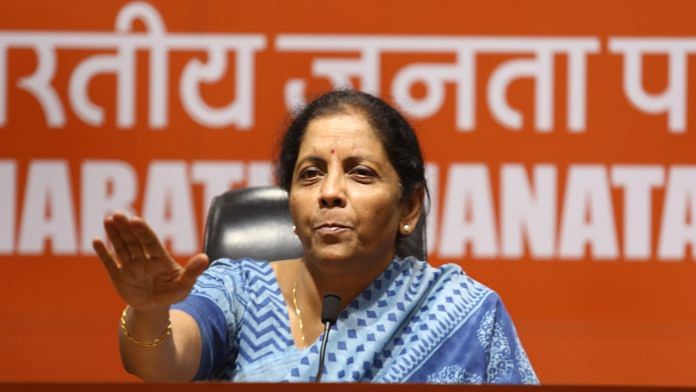The Interim Budget speech on 1 February 2024 by Finance Minister Nirmala Sitharaman was her sixth and the shortest. It was also the least complicated of all her earlier Budget speeches, except for February 2021.
Generally, though, Sitharaman’s speeches are more complex than those given by her predecessors.
Using the Flesch readability ease test, we calculated the complexity metric for each of her Budget speeches since she took over as Finance Minister on 31 May 2019. The test score ranges from 0 to 100, with a higher score suggesting a lower level of reading difficulty.
We evaluated sentence-level sentiment, categorising each sentence as negative, positive, or neutral. The proportion of each sentiment is determined by dividing the count of sentences in each category by the total number of sentences in the speech.
According to our text sentiment analysis, nearly 36.5 per cent of the lines in Sitharaman’s Interim Budget 2024 speech displayed positive sentiments, only marginally lower than in last year’s speech. Around 6 per cent of them had negative sentiments. Compared to other finance ministers in the past 40 years, Sitharaman has delivered speeches with a relatively high positive tone.
In the case of public policy and political communication, text analytics plays a crucial role in identifying patterns in language and sentiment within communication. It can provide valuable insights into understanding how political leaders align the content and tone of their speeches with their stated social and economic policy objectives. It also helps politicians craft effective communication to better connect with their audience.
In India, the finance minister’s annual Budget speeches outline proposed changes in taxation, non-tax revenue such as disinvestment, and government expenditure patterns. More importantly, it is an opportunity for the central government to convey its views on the state of the economy and highlight the focus areas to drive growth and welfare. Since media, analysts, and citizens keenly follow the Budget speech, it is an opportunity for the incumbent government to impress the broader electorate with its social and economic policies.
Also read: India’s public recruitment system stuck in ‘state incapacity’ trap. Can new exam bill save it?
Emphasis on govt schemes, rural India
We analysed Sitharaman’s Budget speeches to identify thematic emphasis over the years. Does the content differ in terms of how much she speaks about, for instance, agriculture, employment, or government schemes?
Six broad themes emerge—macroeconomy (including government spending and revenue), agriculture, industry, environment and sustainability, banking and financial markets, and government schemes.
While presenting Budget over the years, Sitharaman has greatly emphasised different themes. For instance, if we compare the 2020-2021 Budget with the latest one, the share of space given to government schemes has doubled. At the same time, the tax-related portion was reduced by half. It is not a surprise, given that Interim Budgets generally do not propose any changes in the taxation structure.
Over the years, the tax-related theme has revolved around simplifying the tax system, extending tax holidays to priority sectors such as affordable housing projects, and altering customs duties. The latest Interim Budget focused more on recognising the impact of reforms on the current tax structure. More space was also devoted to the expenditure-related details relative to taxation.
More than 14 per cent of the Budget speech contained words related to one or more government schemes, the highest share among all six Budget speeches of Sitharaman. In contrast, her February 2020 speech had only 6 per cent of sentences that mentioned government schemes. In this year’s Interim Budget, the speech had more words such as grameen (rural), farmers, and housing—indicating a focus on rural India in the election year. In contrast, there were fewer references to government schemes for industry.
Since the February 2021 Budget, Sitharaman has often mentioned various climate change initiatives, including the Operation Greens Scheme, Green Credits Programme, and Galvanizing Organic Bio-Agro Resources Dhan (GOBARDhan) Scheme. This year, the government proposed the launch of a new bio-manufacturing and biofoundry scheme.
The phrase Amrit Kaal (loosely translated as a golden era) has been one of the most frequently mentioned phrases in the last three Budgets. Its first occurrence was in the February 2022 Budget, which laid the foundation for the government’s vision for the next 25 years. Budget 2023 marked the 75th year of India’s Independence and was referred to as “the first Budget in Amrit Kaal”. In 2024, a new phrase, Kartavya Kaal (the era of duty/commitment), was introduced to enable a move toward Amrit Kaal.
If the Modi government were to win the Lok Sabha election this summer, how would the finance minister’s Budget speech in July be structured? It wouldn’t be a surprise if it had the most positive sentiments, not only among Sitharaman’s addresses in Parliament but compared to all of her predecessors’ speeches over the last 40-odd years.
Vidya Mahambare is a Professor of Economics and Director (Research) at Great Lakes Institute of Management, Chennai. She tweets @mahambare_vidya. Akash Gupta is an independent researcher. Views are personal.
(Edited by Ratan Priya)



